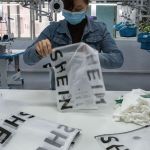
Illustrated sustainability - Interview with WRÅD
The Italian brand explained why fashion is the second most polluting industry in the world
June 5th, 2019
By 2030 the world population will reach 8 billion people and the textile production is destined to increase by 67%, with a consequent increase in water consumption by 51% and energy by 55%.
It's much easier to revisit fashion in purely artistic terms rather than acknowledging that fashion is the second most polluting industry in the world and although sensitivity to the subject has increased in recent years, margins for improvement are great.
We talked about this issue with Italian brand WRÅD, guest of the upcoming White Street Market set for June, for a better understanding in how to avoid the dangers that sustainability may pose, acknowledging also that it may represents nothing more than one of many fads, as opposed to a real sense of urgency.

The final goal must be the transition from a linear economy to a circular economy, which today in the fashion world is unfortunately still far away, we cannot certainly think that the information asymmetry with respect to the real environmental and social cost of fashion is solved when even today in the same fashion houses it is still unknown.


The product must be the manifesto of a message that transcends the product itself, it must not be understood as a product that has an end in itself, functional and aimed simply at increasing the turnover of a company, but as a service, environmental or social, in which the product becomes manifested.
A mission that finds a realization only when it is received by the final consumer, and for this very reason WRÅD's first great effort was to educate.
For the first two years, we have not released anything, our product only entered the market once we managed to develop an innovative process that we believe deserved to be brought to light, amplifying this process through a product that could then inspire other brands. A product as an end in itself is not activism, a product with a purpose is.






In 2015, when the brand began its activity with a training project to bring into schools, the biggest obstacle to overcome was that of institutions. Frequent skepticism was replaced by new common guidelines, collaborations between brands and environmental associations, conferences dedicated to the theme and social campaigns.
Customer awareness has increased thanks to the work of organizations like Fashion Revolution which, through a simple hashtag (#whomademyclothes), has triggered a social media campaign with the aim of asking for greater transparency from brands. Only during the Fashion Revolution week at the end of April, they reached 275 million people.


Communication must help to consider fashion not as any other trend. As Matteo Ward has revealed to us, many times at meetings dedicated to sustainability the same strategies are repeated, the same dynamics with which the collections were treated within the fashion houses.
This approach is fundamentally flawed for two reasons: you cannot think of solving a problem by following the patterns that led to the problem itself and the real reasons behind sustainability campaigns today should not be to acquire a new market share, the consulting agencies from all over the world tell us that the Z generation is attentive to environmental and social values, bad sustainability must be nourished and motivated by a real sense of urgency.

























































